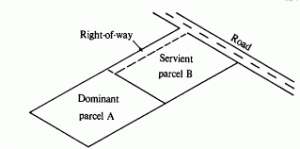What are Easements?
An easement is a right that allows one person to make use of land owned by another person, for a specified purpose. An easement does not allow the person who is benefiting from the right to occupy another person’s land or to exclude others from the land.
Features of an Easement
Apart from easements in gross (see below for further information), easements have a dominant and servient tenement. The land that is burdened by the easement is called the ‘servient tenement’, whilst the land or person that enjoys the right and has the benefit of the easement is known as the ‘dominant tenement’.
More than one property may enjoy the benefit of an easement. For example, a sewerage easement that runs along the rear boundary of properties in an estate is for the benefit of all neighbouring properties that use the sewer laid in the easement. Also, each property is burdened by the easement for the benefit of neighbouring properties.
If the easement only benefits an individual personally, not as an owner of a particular piece of land, the easement is an easement in gross. An easement in gross will have a servient tenement, being the property over which the easement exists, but will not have an identifiable dominant tenement. An easement in gross can only be created in favour of a government authority or service provider e.g., municipal council or the water authority.
 Creation of Easements
Creation of Easements
Easements can be created as a result of an agreement between the dominant and servient owner. The parties will determine the rights and obligations they and all subsequent owners will have with respect to the easement. Parties can determine these rights in two ways, either the servient owner may grant the dominant owner an easement over the land or a vendor may reserve an easement over the land when transferring it to a purchaser for the benefit of other adjacent lands the vendor owns.
One of the most common ways for easements to be created is upon registration of a plan of subdivision. The developer of land must ordinarily apply to a responsible authority, usually the municipal council, for a permit to subdivide the land. The responsible authority must provide all relevant referral authorities (gas, water and sewerage authorities) with a copy of the permit application. The referral authorities have the right to create easements on the subject land for the provision of services. When the works are completed by the developer, the responsible authority will certify the plan after checking that it includes the easements required by the referral authorities. When the certified plan of subdivision is registered at the Land Titles Office, the easements will be shown on the plan.
Statutes allow government authorities and service providers to utilise easements in gross, even in situations where the right in question is not taken for the benefit of the land of the authority.
Under section 36 of the Subdivision Act 1988 (Vic) an owner of land may acquire an easement compulsorily over other land in a subdivision or consolidation. An applicant can compulsorily acquire an easement by the relevant council issuing a permit, the relevant council issuing a written statement conveying the view that the economical and efficient access to the land requires the owner of the land to acquire an easement over other land and that the acquisition of the easement will not result in an unreasonable loss or amenity in the area affected by the acquisition or by VCAT granting leave to hear the application.
Registration of Easements
In order to ensure that the easement is valid and binding on all future owners, the easement must be registered. Registered interests are statutory interests that cannot be annulled or set aside unless obtained through fraud.
Merger of Interests
For an easement to exist the dominant and servient tenements must be in different ownership. If the two properties come into common ownership the easement will merge.
Interference or Obstruction of Easement
Interference with or obstruction of an easement constitutes a nuisance, and the following remedies are available.
- Abatement
At common law, the owner of the dominant land may enter the servient land and remove any obstruction preventing the use of the easement.
- Declaration
Where a plaintiff asserts that his or her legal or equitable rights have been infringed by the defendant, in addition to any other remedies, the plaintiff can ask the court to declare what the plaintiff’s rights are and that those rights have been infringed.
- Injunction
If it is alleged an easement has been obstructed, an injunction will be sought instead of a declaration. An injunction is the most effective remedy the law has to prevent the infringement of lawful rights and is granted when damages are not an adequate remedy.
- Damages
Damages can be awarded at common law or in equity, either in substitution for or in addition to an injunction.
For further information on easements and your rights in relation to easements, please contact us at property@ballaratlawyers.com.au or on 5303 0281.
For more information on our conveyancing arm, click here.
The information on this website is of a general nature only. It is not, nor is it intended to be, legal advice. You should consult a lawyer for individual advice about your particular circumstances.
Liability is limited by a scheme approved under Professional Standards Legislation.
Click here to go back to Publications.
